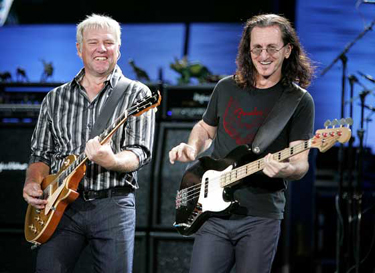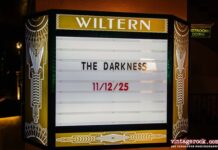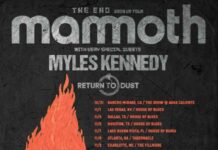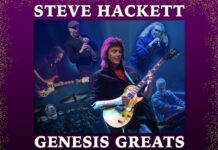When I think in terms of durability as applied to the rock and roll game, I think of Rush. Somehow, they’ve survived the trends, tribulations and trials that devour so many of their peers. Despite the usual obstacles, they continue, after 35 years, to make new music and play before SRO audiences all over the world. Through it all, Alex Lifeson, Geddy Lee and Neil Peart have developed and maintained their integrity, their chops and a wildly wicked sense of humor.
So how is it that a hard rock power trio from Canada with an over-active imagination has become such an iconic band? As usual, I have a few misconstrued theories that may or may not resonate with the peanut gallery. If we coast back a few decades, say to the 70s, Rush paid their dues and attempted to establish an identity and distinguish themselves from the crowd. Once drummer John Rutsey aborted the throne (due to apparent health reasons) and Neil Peart took over, things suddenly took a tumble for the better.
For one, Peart wasn’t just your average, run-of-the-mill replacement; he was an exceptional drummer with an incalculable style. Peart was (and still is) also a highly evolved intellectual, extremely literate and well read, especially when it came to science fiction and the works of novelist/philosopher Ayn Rand. His voracious reading habits translated seamlessly into a refined skill of stringing words together – weaving futuristic fables intertwined with bits and pieces of objectivism – to create inspired lyrics that shifted and shaped their rhapsodic richness within the heavily textured melodies and pentatonic scales etched out by Lifeson and Lee.
Time And Motion
Fly By Night and Caress Of Steel, Rush’s second and third albums from 1975, did wonders to catapult the band to the frontlines. Instead of being lumped in with the mass of hard rock bands of the day, Rush fell in with the snootier prog rockers. Peart’s cerebral lyrics for songs like “Anthem” and “By-Tor And The Snow Dog” infused a new level of sophistication to the repertoire, while epics like “The Necromancer” and “The Fountain of Lamneth,” both from Caress Of Steel, set the stage for the group’s monolithic breakthrough, 2112.
To this day, many hardcore fans consider 2112 a feather in Rush’s flat-brimmed mountie. It certainly set a precedent for how far conceptually the group was willing to stretch. But alas, it would also be the last epic piece of its type from Rush. With their newfound success, the group suddenly did a turnabout, streamlining their formula and condensing the highbrow themes into shorter, more user-friendly compositions. Even as long-form pieces like “Xanadu,” “Cygnus X-1 Book II Hemispheres: Prelude/Apollo Bringer of Wisdom/Dion,” and “Natural Science” continued to infiltrate Rush records until the end of the 70s, it was “Closer To The Heart,” “Freewill” and “The Spirit Of Radio” that garnered airplay and paved the way for the group’s prominence in the 80s. Once Moving Pictures hit the streets, there was no question that Rush was much more than a flash in the pan.
For someone like me who leapfrogged over some of the group’s late 70s/early 80s albums, Moving Pictures was a mindbender. The most extraordinary memory I have of this album is that it was the first compact disc I ever bought. It was 1983 and I clearly remember paying $300 for a single CD player made by Sharp, and then wondering what I was going to play on it. The sales guy said they only made CDs in West Germany, but if they caught on, they’d start mass-producing them in the States. He explained they were in the process of building production plants all over the world. That almost killed my excitement over buying the CD player until he played Moving Pictures. Without hesitation, I pulled out $15 and bought it.

I went home, hooked up my new CD player, carefully placed the Moving Pictures CD on the slide-out tray, pushed the close button and waited for the fireworks. “Tom Sawyer” oozed out of my oversized speakers and massaged the room with aural pleasure. When the opening tinkles of “Yyz” panned from one speaker to the other before blasting off into a stop-and-start free-for-all, I knew I had picked the right disc to start my collection.
From there on out, I was pretty much on hooked on whatever the Canadian power trio released. Like ZZ Top, another well-known trio, Rush carefully adapted to the sights and sounds of the 80s — generously working the synthesizer into the mix on songs like “Subdivisions” and “The Big Money,” and making videos to promote their records— yet they never seemed to stray too far from their hard/prog rock roots.
By the time the 90s rolled around, the group returned to form and continued to sell records at a brisk pace. And while I still followed their career, it was at a comfortable distance. Truth be told, I went to a couple of Rush shows, and just about fell asleep from boredom. For as much as I liked their music and appreciated their artistry, I didn’t find them the least bit interesting as stage performers. That would change in the 21st century.
New World Band
In the late 90s, Peart suffered a devastating personal blow: his daughter was tragically killed in an auto accident in August 1997; less than a year later, his wife passed away from cancer. Their future up in the air, Rush went on an extended hiatus — Lee made a solo album, Lifeson dabbled in various musical and non-musical projects, and Peart hopped on his motorcycle, traveled the world and mourned the loss of his loved ones. The drummer eventually remarried, and agreed to rejoin his band mates for another record. He also became an accomplished author, publishing several books about his travels and life.
Perhaps the most remarkable thing about Rush’s return in the new millennium was their continued popularity. There aren’t too many bands that can stay away from the madness for five years, and come back as strong as ever. And even though Vapor Trails, their 2002 comeback album, was met with mixed reviews and lower-than-expected sales, fans still swarmed to their concerts. To help solidify their reign, a few other arbitrary releases found their way to the marketplace. There was the Rush In Rio CD and DVD that went gold and even warranted a Grammy nomination. Then in 2004 the band came out of left field with Feedback, an eight-song EP filled with covers that stripped away the pretentious, pompous label and cast a new light on Rush as a hot little rock and roll band who graciously embraced their influences.
They hit the road again in 2004 to celebrate their 30th anniversary and released another live DVD called R30, which featured a show from Frankfurt, Germany, as well as rare archival footage from the band’s colorful history. As if the Rush-loving public wasn’t being inundated with enough live material, Rush Replay X3, a three-DVD set consisting of three previously released home videos, hit the streets in 2006. Watching this set, I came to the realization that Rush was an exciting live band when seen up close and personal. I felt ashamed of my slumberous ways, and was determined to seek them out the next time they came to town. It turned out to be one of my better decisions.
Snakes & Arrows

With the release of their 2007 studio album, Snakes & Arrows, Rush reclaimed their supremacy as a superlative classic rock band while digging their heels in deep for one of the most enjoyable offerings of their career. Lifeson comes our swinging with some truly solid, mind-numbing guitar work — something he eschewed on many of the group’s albums from the 80s and 90s. Of course, Lee and Peart fall in behind as a first-rate rhythm section, paving a trail for a wild and organic collection that builds and expands on a diverse catalog. But the best part of Snakes & Arrows was the shows that followed in its wake.
Three days after blowing out the Hollywood Bowl, Rush ventured south to Orange County to play the Verizon Wireless Amphitheater (formerly Irvine Meadows), an inviting, open-air venue a stone’s throw from the “Y” of Interstate 5 and 405. After a lengthy walk from the parking lot, ticket holders are greeted with a ragtag variety of culinary delights, swag and $12 Coronas (ouch!).
Finding my seat a few rows behind the mixing desk, I took in the stage set up with a mixture of bemusement and wonder. For this tour, Peart’s drum riser is situated between a wall of Lifeson’s four Hughes & Kettner stacks and what appear to be three tall “Henhouse” rotisserie chicken ovens. Yes, you read that right — chicken ovens! Rush is the only group I know of who can successfully incorporate household appliances into their stage set. For all I know they could be working on a Sears endorsement for their next tour. Nevertheless, the mere presence of these giant ovens, populated with dripping, spittled chickens no less, was enough to fill me with anticipation. With no opening act to be had, I sat back and prepared myself for what turned out to be a magnificent three-hour performance.
At precisely 7:45 PM, the video screens lit up and a sudden hush fell over the crowd as Lifeson, Peart and Lee (in two distinctively different roles) appeared with aplomb crossed with insanity in a comical sequence that segued into the actual band members sprinting onto the stage, taking their places and opening with “Limelight” from Moving Pictures. The stage lighting twisted and turned as Rush locked in as tight as a fist ready to punch out a feisty opponent. Always a crowd-pleaser, the driving riff ripped and roared into the warm summer night sky, and the audience surged forth, salivating for more. That they got as Peart spun out a simple drum roll and the band went into the funky, reggae-like “Digital Man” from 1982’s Signals. More favorites from the 80s were shuffled out and given the one-over — “Entre Nous” and “Freewill” from 1980’s Permanent Waves and “Mission” from 1987’s Hold Your Fire — before the band took a breath and reconvened.
Lee acknowledged the location by playfully blurting out: “Orange County…Anaheim…whatever,” followed by the announcement that band would now play some new songs from their “4,000th album.” He wasn’t too far off when you consider the group has consistently been releasing albums for most of their 35 years together. “The Main Monkey Business” and “The Larger Bowl” both received doses of stunning visual accompaniment. The former, one of three instrumentals from Snakes & Arrows, was embellished with various video shots of, what else, monkeys, while the latter was introduced by Bob and Doug McKenzie, the beer-loving brothers and hosts of SCTV’s The Great White North who previously collaborated with Geddy Lee on “Take Off.” Despite the comical introduction, “The Larger Bowl” actually explores the imbalance of life with lyrics like, “Some are blessed and some are cursed/The golden one or scarred from birth/While others only see the worst/Such a lot of pain on the earth…” Oh the irony.

As various female chefs paraded out intermittingly to baste the rotating chickens, Rush started pulling out cool, somewhat obscure albums tracks, dazzling the flock with each and every lick as lasers darted and dodged the amphitheater. Lifeson and his arsenal of Les Pauls never failed in the six-string histrionics; Peart, regimented and stoned-faced, attacked his drums like a Buddhist monk on a mission. Lee, of course, sang and played his bass with brash confidence and majestic authority. That high-pitched voice — a voice that actually used to make my ears scream for mercy — has, in recent years, assumed an entirely different dimension, serving the songs instead of defiling them. By the end of the first set, I was drained, drenched and aching for more.
During the intermission, I spent an agonizing 20 minutes standing in line to relieve my bladder. Once I retraced my steps back to my seat, I was ready to receive my penance. The stir of a storm startled everyone before the video screens fired up on a sundry of characterizations — The Plane of Cosmic Consciousness, The Plane of Primal Vibrations, Envy (“I wish I was just like you — beautiful and rich”), The Plane of Dharma, and finally The Birth of Man — before Rush bounced back onto the stage to play “Far Cry,” the powerful opening number off Snakes & Arrows.
The crowd was inspired and on its feet as the band swayed and swirled. Flash pods popped and plundered, building the momentum to a kinetic intensity. Four more new ones — “Workin’ Them Angels,” “Armor And Sword,” “Spindrift” and “The Way The Wind Blows” — were unveiled and showed off like a group of newborns. What amazed me was how receptive the multitudes were to these tunes — a rare thing in a world of instant gratification and familiarity. By the time “Subdivisions” and “Natural Science” came along, I was beginning to wonder what other tricks these Canucks had up their sleeves. And that’s when Peart took the spotlight and played one of the most entertaining drum solos I have ever witnessed.
We all know the story: the drum solo comes along and you head to the snack bar for another beer. But with Peart, you don’t so much as dance away as you marvel at the man’s dexterity and dedication to his instrument. The twirling riser, the old switcheroo to the electronic drums, the percussional superfluities, and the big-band finale — each of these elements made Peart’s few moments of isolation a riveting experience to behold.
And just when I thought the group could go no further, they exploded with a flurry of delight. Lifeson plucked out a few notes on his acoustic before switching to yet another Les Paul. The Hendrix-inspired guitar lines took “Summertime Blues” to another plateau. “The Spirit Of Radio” and “Tom Sawyer,” with a short video intro from the South Park kids, demonstrated that the band’s two most well-known hits are no worse for the wear. “A Passage to Bangkok” from 2112 gave the old-timers the thrill of a lifetime before “YYZ” came along and gobbled up the last vestiges of time in grand style. The band took their bows and made their exit, and a wave of joy and exultation swept over my soul. At that precise moment, I realized rock and roll concerts can still be stirring, emotional experiences. Music as a profitable medium may be suffering under its delusion, but when a veteran band like Rush can still fire on all cylinders without succumbing to the pressure of fluffy mediocrity, there’s still a glimmer of hope that integrity will once and for all win out the battle for salvation. That and a few rotating chickens certainly go a long way.





















